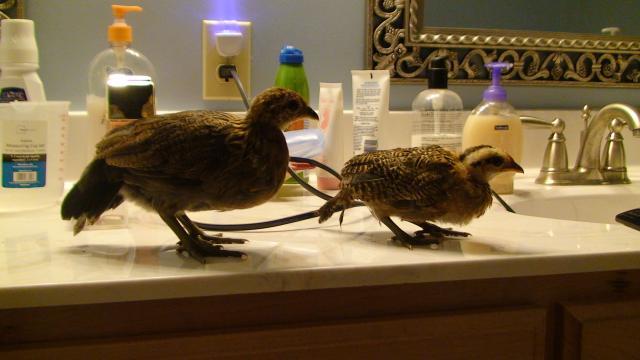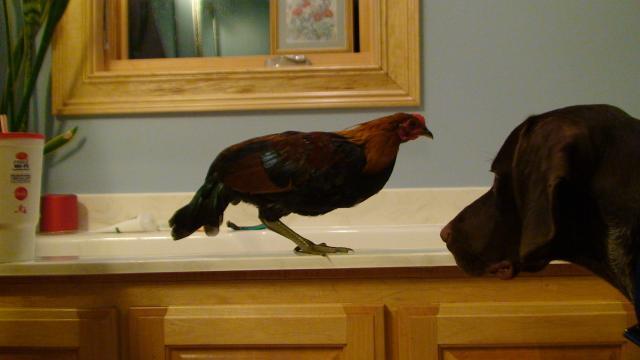Show a picture of him. Sometimes it pays to treat symptoms in addition to the cause already being addressed. I suggest adding electrolytes to the water and paying closer attention to be the birds compromised ability to thermoregulate by providing chick the option of approaching a heat lamp.
Navigation
Install the app
How to install the app on iOS
Follow along with the video below to see how to install our site as a web app on your home screen.
Note: This feature may not be available in some browsers.
More options
You are using an out of date browser. It may not display this or other websites correctly.
You should upgrade or use an alternative browser.
You should upgrade or use an alternative browser.
Cocci in baby chick
- Thread starter ashlierami
- Start date
Below is a picture of two full-sibling chicks after chick on right suffered and began recovery from heavy cocci infection back in 2011. Affected chick was male. Despite stunting as chick transitioning to the juvenile stage (acquisition of juvenile characteristics delayed by almost 2 weeks), he did catch up with siblings with respect to final size. It took him an additional month to fill out.


A problem I noted at the time was he and the other affected chicks (all infected but only some strongly affected) had serious trouble staying warm for about a week. During early morning hours the affected chicks spent a lot more time sunning themselves and moving slowly about with droopy wings. As the day progressed and temperature got into the realm of being very unpleasant for me in the high 90's F the affected chicks got stronger. Process repeated each day. Fluid intake by affected chicks was much higher.
Somewhere I have pictures showing how feather growth was impacted. Looks like what you see in tree rings and fish scales.
My gut feeling is they got very little benefit from eating food for at least a couple of days. It might have even been counterproductive. I battle cocci every year when is rains heavy and getting better with its management each time. Reacting quickly is very important. The first sign I look is better classified as a symptom, the chicks complain more through cheeping loudly.


A problem I noted at the time was he and the other affected chicks (all infected but only some strongly affected) had serious trouble staying warm for about a week. During early morning hours the affected chicks spent a lot more time sunning themselves and moving slowly about with droopy wings. As the day progressed and temperature got into the realm of being very unpleasant for me in the high 90's F the affected chicks got stronger. Process repeated each day. Fluid intake by affected chicks was much higher.
Somewhere I have pictures showing how feather growth was impacted. Looks like what you see in tree rings and fish scales.
My gut feeling is they got very little benefit from eating food for at least a couple of days. It might have even been counterproductive. I battle cocci every year when is rains heavy and getting better with its management each time. Reacting quickly is very important. The first sign I look is better classified as a symptom, the chicks complain more through cheeping loudly.
Great post! What most people don't realize it that almost all sick birds will be hypothermic (too cold) and will require a heat source or better yet, a cage in a warm room.A problem I noted at the time was he and the other affected chicks (all infected but only some strongly affected) had serious trouble staying warm for about a week.
You must be careful with the heat source. I cooked a few before resorting to using a much larger brooder. I now setup so heat lamp shines on a spot in garage with water very close by. When the chicks are really weak they do not seem to realize they are getting too hot.
Which is why I said "better yet, a cage in a warm room". I don't like using heat lamp with sick birds, but it's often the only choice people have.You must be careful with the heat source. I cooked a few before resorting to using a much larger brooder. I now setup so heat lamp shines on a spot in garage with water very close by. When the chicks are really weak they do not seem to realize they are getting too hot.

Similar threads
New posts New threads Active threads
-
Latest posts
-
-
No tails and some bald backs and other spots.
- Latest: rosemarythyme
-
-
-
-
Latest threads
-
I rescued two roosters, and, um, one disappeared.
- Started by fat brown hen
- Replies: 1
-
Sand in coop and on poop shelf
- Started by LCchickens71
- Replies: 0
-
-
-
-
-
Threads with more replies in the last 15 days
-
-
Question of the Day - Saturday, July 12th, 2025
- Started by casportpony
- Replies: 164
-
-
-
-
×



